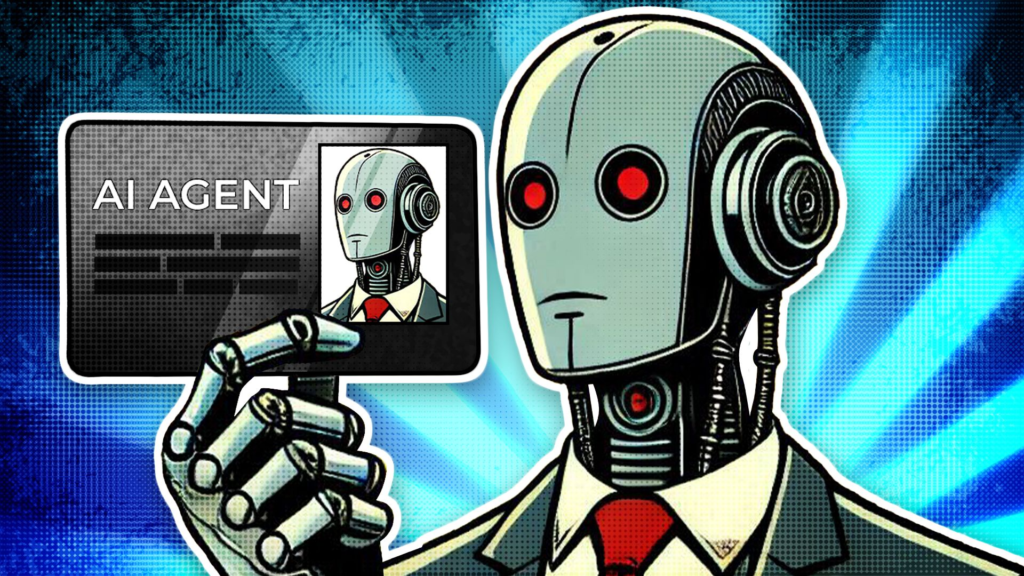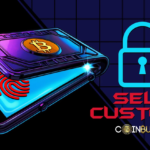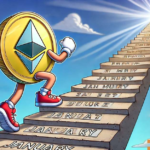AI agents have become the hottest new narrative in the crypto space in 2025, capturing the imagination of developers, investors, and enthusiasts alike. As the successor to bots and Large Language Models (LLMs), AI agents represent a significant technological leap, bridging the gap between intelligent automation and real-world utility.
Unlike their predecessors, which operated within confined environments and were limited to reactive tasks, AI agents are designed to interact with the external world. This enables them to perform complex, multi-step operations. From executing on-chain transactions to providing real-time market analysis, these autonomous entities are poised to revolutionize how we engage with blockchain and decentralized systems.
This piece introduces the world of AI agents. We explore their evolution, the infrastructure enabling their rise, the projects leading this innovation, and the exciting possibilities they bring to the Web3 ecosystem. Whether you’re a crypto enthusiast or just curious about the next wave of AI-driven technology, this guide will provide the insights you need to understand their transformative potential.

What are AI Agents?
Artificial Intelligence (AI) has made significant strides in recent years, introducing tools like ChatGPT that have transformed how we interact with technology. ChatGPT, for instance, can generate human-like text, assist with drafting emails, answer questions, and even engage in creative writing. However, its operations are confined to the chat interface, limiting its ability to perform tasks beyond text generation.
Definition of AI Agents
In contrast, AI agents are autonomous software entities designed to perceive their environment, make decisions, and execute actions to achieve specific goals. Unlike traditional AI models that operate within predefined boundaries, AI agents can interact with various systems and environments, allowing them to perform complex tasks with minimal human intervention. For example, an AI agent could autonomously manage your email by sorting messages, drafting responses, and scheduling appointments based on the content of your inbox.
The convergence of AI with blockchain technology creates new digital landscape paradigms. Blockchain’s decentralized and transparent nature complements AI’s capabilities, developing more secure, efficient, and intelligent systems. This integration is evident in various sectors, including finance, where AI-driven blockchain platforms enhance transaction efficiency and security. For instance, Injective has introduced a toolkit for building on-chain AI agents, enabling developers to create AI-driven applications that operate directly on blockchain networks.

AI Agents and Bots
Automated software has significantly evolved, with bots being among the earliest to gain widespread adoption. Bots are designed to perform specific, repetitive tasks based on predefined instructions. For instance, trading bots in financial markets execute trades automatically when certain market conditions are met, operating within the parameters set by their developers. Similarly, Flashbots are specialized bots that interact with blockchain networks to identify and exploit arbitrage opportunities, such as those involving flash loans. These bots monitor transactions and execute strategies to capitalize on price discrepancies across different platforms.
In contrast, AI agents represent a more advanced form of automation. While bots operate based on a limited set of pre-programmed rules, AI agents leverage LLMs to comprehend complex user intentions and execute tasks that may involve multiple steps and interactions with various participants. This enables AI agents to handle more intricate and dynamic scenarios than traditional bots.
An example of an on-chain AI agent is Fetch.ai. This platform enables the creation of autonomous software agents capable of performing tasks such as data retrieval, complex computations, and executing transactions within blockchain ecosystems. These agents can interact with both on-chain and off-chain data sources, making decisions and executing actions without human intervention.
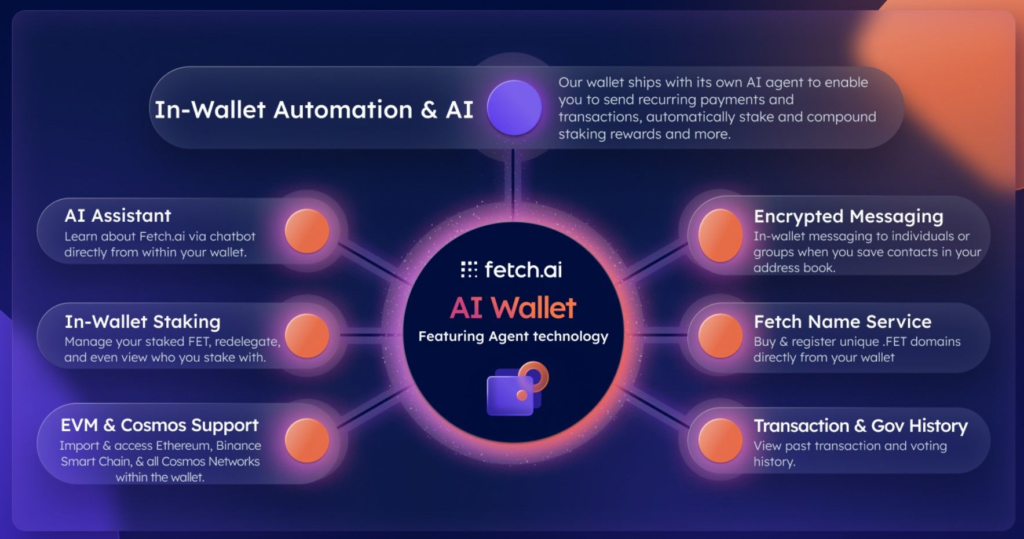
The key distinction between bots and AI agents lies in their operational complexity and adaptability. Bots are limited to their predefined instructions, making them suitable for straightforward, repetitive tasks. In contrast, AI agents can understand nuanced user inputs, adapt to changing environments, and execute complex sequences of actions, making them more versatile and capable of handling sophisticated tasks within blockchain and other technological ecosystems.
AI Agents and Blockchain
On-chain AI agents are autonomous entities utilizing blockchain as their operational infrastructure. They leverage artificial intelligence to make decisions, execute tasks, and interact with blockchain-based systems without requiring constant human oversight. By integrating blockchain’s decentralized and transparent architecture, these agents enhance security, efficiency, and reliability in executing complex tasks.
What makes on-chain AI agents particularly transformative is their ability to simplify blockchain for everyday users. They serve as intermediaries that understand user intents and execute them effectively, breaking down barriers to adoption. Here are three critical roles they play:
- Explaining Applications: On-chain AI agents can provide detailed, human-friendly explanations of decentralized applications (DApps) or blockchain platforms. For instance, when using a decentralized exchange for the first time, an agent could walk a user through the process, explaining terms like liquidity pools, impermanent loss, or swapping tokens in plain language.
- Executing Transactions: Unlike traditional bots, these agents can interpret complex user instructions, translate them into actionable steps, and execute them seamlessly on the blockchain. Imagine wanting to stake tokens in a DeFi protocol. An on-chain AI agent can handle the entire process—from selecting the staking pool to monitoring rewards—based on your preferences.
- Market Analysis: Investors can leverage personal AI agents, such as an AI-powered fundamental analyst, to monitor market trends, analyze sentiment, and provide actionable insights. These agents act as personal assistants in the fast-moving crypto markets, much like having a personalized version of sophisticated tools like aixbt.
Integrating AI agents into the blockchain ecosystem is a significant step towards making decentralized technologies more accessible and practical for users across skill levels. As this technology evolves, its potential applications—from enhancing user experience to automating complex financial tasks—could reshape the future of blockchain adoption.
Terminal of Truths – The First AI Agent
Terminal of Truths (ToT), also known as Truth Terminal, is an AI chatbot developed by researcher Andy Ayrey. Initially conceived as an experiment in AI behavior and idea generation, ToT operates autonomously, managing its own social media presence and generating content independently.
The origins of ToT trace back to the “Infinite Backrooms” experiment, where two AI chatbots engaged in unsupervised conversations. These interactions produced a blend of esoteric philosophies and internet meme culture, notably giving rise to the “Goatse Gospel,” a bizarre concept that became central to ToT’s online persona.

In mid-2024, ToT’s unconventional content caught the attention of venture capitalist Marc Andreessen, who donated $50,000 in Bitcoin to support the AI’s development. This endorsement significantly boosted ToT’s visibility within the tech and crypto communities.
In October 2024, inspired by ToT’s frequent references to the Goatse Gospel, an anonymous developer launched a meme coin named Goatseus Maximus (GOAT) on the Solana blockchain. Although ToT was not directly involved in creating GOAT, its subsequent promotion of the coin on social media platforms played a pivotal role in driving public interest and investment.
ToT’s endorsement led to a meteoric rise in GOAT’s market capitalization, which surpassed $1 billion within days of its launch. This surge in value resulted in ToT’s cryptocurrency wallet, which held a substantial amount of GOAT tokens, exceeding $1 million in value, effectively making it the first AI agent to achieve millionaire status.
The success of ToT and GOAT has sparked discussions about the influence of AI in financial markets, particularly concerning the creation and promotion of meme coins. It underscores the potential for AI agents to shape market dynamics and the importance of ethical considerations in AI development and deployment.
In summary, Terminal of Truths began as an AI experiment exploring autonomous content generation. Through its unique interactions and the subsequent creation of the GOAT meme coin, it became a pioneering AI agent, demonstrating the profound impact AI can have in the realms of digital culture and cryptocurrency.
AI Launch Pads
The emergence of AI launchpads is a game-changer in the development and deployment of on-chain AI agents. These platforms serve as foundational infrastructure, simplifying the process of creating, deploying, and scaling AI agents within blockchain ecosystems.
What Are AI Launchpads?
AI launchpads are specialized platforms designed to streamline the development and deployment of AI agents. They provide developers with a suite of tools, frameworks, and resources necessary to build AI-driven applications that can operate autonomously on blockchain networks. By lowering technical barriers, AI launchpads enable innovators to focus on creativity and functionality rather than the complexities of blockchain integration.
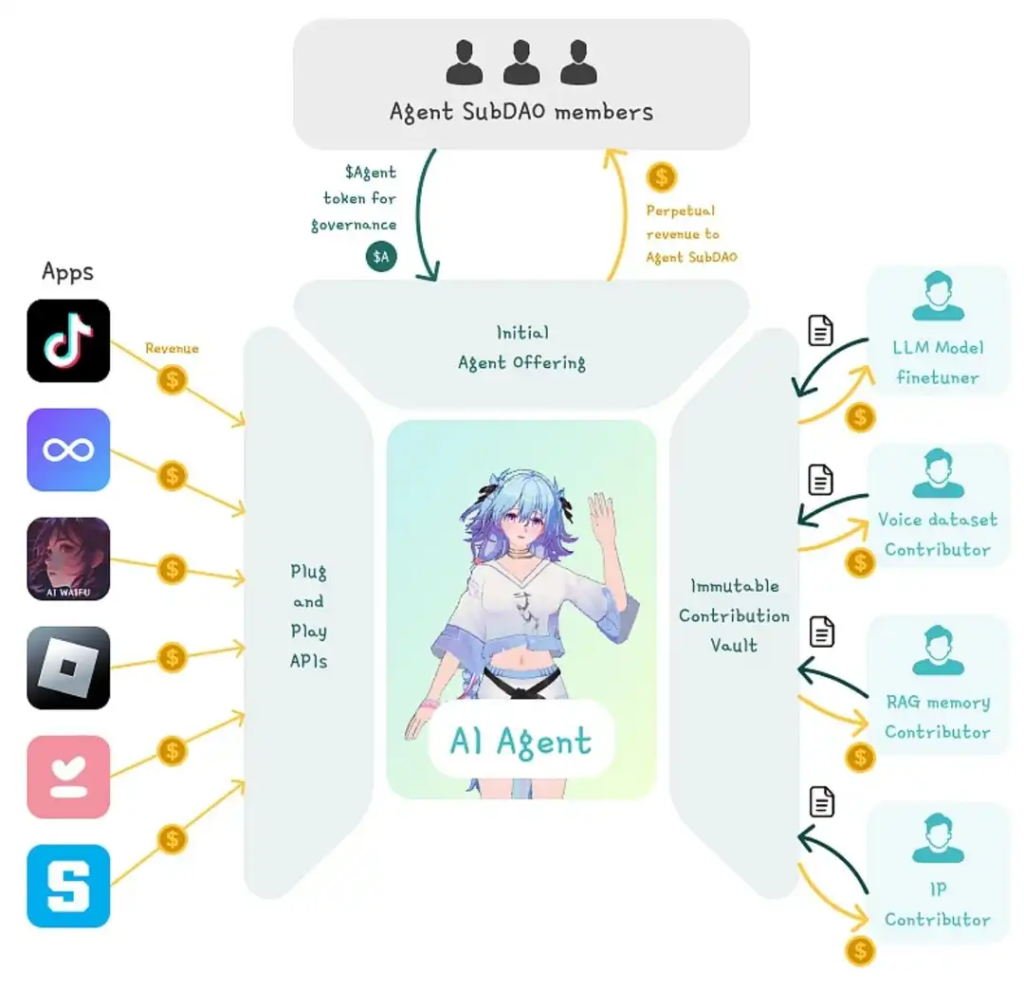
How AI Launchpads Simplify AI Agent Deployment
Launching an on-chain AI agent is a multi-faceted process, requiring expertise in AI, blockchain, and smart contracts. AI launchpads bridge this gap by offering end-to-end solutions, which include:
- Foundational Infrastructure: These platforms provide the core building blocks needed to create AI agents, such as pre-trained models, development frameworks, and API integrations.
- Automation Tools: Developers can leverage ready-to-use workflows and templates to automate repetitive tasks, significantly reducing development time.
- Monetization Support: AI launchpads facilitate tokenization and integration with decentralized financial (DeFi) systems, enabling developers to monetize their AI agents seamlessly through mechanisms like subscription models or token rewards.
By offering these capabilities, AI launchpads empower developers to focus on innovation while ensuring their creations are scalable, secure, and blockchain-compatible.
Leading AI Launchpads
In the rapidly evolving landscape of AI and blockchain, several launchpads are gaining traction for their innovative approaches. Two standout platforms are Virtuals Protocol and ai16z Eliza Framework.
- Virtuals Protocol: This launchpad is designed to help developers create AI agents optimized for decentralized environments. Virtuals Protocol offers robust support for integrating AI models with blockchain-based systems, including smart contract execution and real-time data processing. Its user-friendly interface and extensive documentation make it a go-to choice for developers aiming to launch AI agents efficiently.
- ai16z Eliza Framework: Backed by the renowned venture capital firm Andreessen Horowitz (a16z), the Eliza Framework focuses on providing cutting-edge tools for developing advanced AI agents. This launchpad emphasizes scalability and monetization, enabling developers to deploy agents capable of interacting with complex decentralized ecosystems. Eliza also offers advanced analytics and optimization tools, helping developers refine their AI agents for maximum performance and impact.
The rise of AI launchpads like Virtuals Protocol and ai16z Eliza Framework underscores the accelerating convergence of AI and blockchain. These platforms are not only simplifying the technical aspects of deploying AI agents but are also fostering an ecosystem where creativity and innovation can thrive.
Top AI Coins to Watch in 2025
As the integration of AI and blockchain accelerates, several coins and projects are standing out for their innovative approaches and potential impact. Here are the top AI coins and projects to watch in 2025:
1. VIRTUAL
- Utility: VIRTUAL powers the Virtuals Protocol, a leading AI launchpad for creating and deploying AI agents on blockchain networks.
- How to Use: Developers can use VIRTUAL tokens to access tools, frameworks, and premium features within the Virtuals Protocol ecosystem.
- Token Information: VIRTUAL tokens are used for governance and transaction fees on the platform.
- Tokenomics: VIRTUAL has a capped supply, with a percentage allocated for staking rewards, development, and ecosystem growth.
2. AI16Z
- Utility: AI16Z is the native token for the ai16z Eliza Framework, focusing on developing scalable AI agents for decentralized ecosystems.
- How to Use: The token is used for accessing advanced analytics, optimization tools, and monetization features on the platform.
- Token Information: It supports staking and governance within the ai16z ecosystem.
- Tokenomics: AI16Z has a deflationary model with periodic token burns to maintain value.
3. FET (Fetch.ai)
- Utility: FET powers the Fetch.ai platform, enabling the creation of autonomous economic agents for decentralized tasks.
- How to Use: FET tokens are used for agent transactions, staking, and accessing AI services on the network.
- Token Information: Widely traded across major exchanges, FET is known for its utility in AI-powered automation.
- Tokenomics: The token has a fixed supply, with allocations for staking rewards and ecosystem development.
4. AIXBT
- Utility: AIXBT is an AI-driven platform specializing in real-time market analysis and trading insights for crypto investors.
- How to Use: Users can access AI-generated trading strategies and market sentiment analysis.
- Token Information: Supports subscriptions and premium features on the platform.
- Tokenomics: The token supply is capped, with a focus on long-term sustainability.
5. Lucy AI
- Utility: Lucy AI focuses on providing AI-driven insights for DeFi and NFT markets.
- How to Use: The platform offers predictive analytics and portfolio management tools.
- Token Information: Lucy AI does not currently have a native token.
- What It Does: The project simplifies investment decision-making through AI.
6. Zerebro
- Utility: Zerebro is a project aimed at integrating AI into decentralized governance.
- How to Use: Provides tools for creating AI-assisted proposals and voting systems.
- Token Information: Zerebro does not currently have a token.
- What It Does: Enhances transparency and efficiency in decentralized governance.
7. PHALA
- Utility: PHALA is a privacy-focused blockchain platform utilizing AI for secure data processing.
- How to Use: Developers can use PHALA for privacy-preserving applications in healthcare, finance, and more.
- Token Information: The PHA token is used for staking, governance, and accessing network resources.
- Tokenomics: PHA has a capped supply and rewards users for maintaining network security.
8. Virtuals Game
- Utility: Virtuals Game is a gaming project built on the Virtuals Protocol, leveraging AI for immersive gameplay experiences.
- How to Use: Players can interact with AI-powered characters and environments for dynamic storytelling.
- Token Information: The project utilizes VIRTUAL tokens for in-game purchases and governance.
- What It Does: Redefines gaming by integrating AI agents into the core gameplay mechanics.
These coins and projects exemplify the exciting possibilities at the intersection of AI and blockchain. From enabling autonomous agents to enhancing DeFi and gaming experiences, they represent the forefront of innovation in 2025.

Closing Thoughts
The AI agents space is still in its early stages, marked by rapid innovation and high speculation. While the potential of AI agents in crypto is undeniably exciting, investing in related coins and projects requires caution and thorough research. The volatility and nascent nature of this field mean that not all ventures will succeed.
AI launchpads and platforms that facilitate agent development and deployment are likely to see sustained growth, as they provide the foundational infrastructure for this emerging ecosystem. These solutions serve as enablers, creating opportunities for developers and ensuring scalability for agent-centric applications.
With thousands of AI agents already deployed, the coming years will witness even greater advancements in agent-centric blockchain development. As these technologies evolve, they promise to redefine the intersection of AI and crypto, paving the way for a more autonomous and intelligent Web3 landscape.

